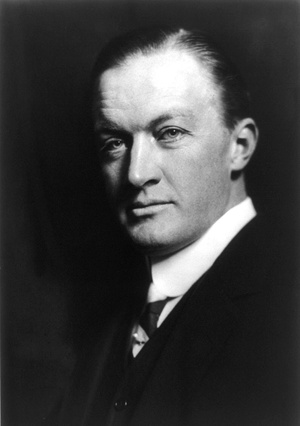 John Russell Pope, 1911
John Russell Pope, 1911
(Wikipedia)
Born: 1874
Died: 1937
Married: Sadie Jones
Children: Mary and Jane Pope
John Russell Pope, the last great American neo-classical architect, famous for many Washington, DC buildings, also designed buildings for Gabriels Sanatorium between 1925 and 1931.
Both of Pope’s parents were artists, so he was brought up to appreciate beauty. His uncle, Dr. Alfred Loomis, a prominent NYC physician, influenced him to study medicine, which he did at CCNY. His best grades were in drawing however, and after he observed an operation he decided against medicine and switched to architecture at Columbia, graduating in 1894. In 1895 he won the McKim (of McKim, Mead & White) Traveling Fellowship as well as first prize of the American School of Architecture in Rome, Italy. He traveled to Rome and around Italy for 18 months and then attended the École des Beaux-Arts in Paris. He returned to New York City in 1900, fully steeped in the classical style and tradition.
He then entered the office of the architect Bruce Price but by 1903 he was practicing on his own. The Vanderbilt gatehouse, designed in 1905, attracted the attention of the press and helped him gain further commissions from Vanderbilt and his friends.
Pope designed over 200 projects during his career. In New York State, ten are on the National Register of Historic Places, including the City Hall (1917) and Macdonough Monument (1926) in Plattsburgh, the Roosevelt wing of the American Museum of Natural History in NYC (1929), the Marshall Field estate on Long Island (1925) the Vanderbilt residence in Manhattan (1930-31) and buildings on the Syracuse University and Hartwick College campuses. In the Adirondacks, in addition to the buildings at Gabriels Sanatorium, he was the principal architect for Camp Kill Kare near Raquette Lake.
Pope’s most famous projects were in Washington, DC where he designed the National Archives (1933-35), the National Gallery of Art (1937-41), and the Jefferson Memorial (1937-1943), the latter two completed after his death. Other major projects in the District of Columbia are Constitution Hall for the Daughters of the American Revolution, the Temple of the Scottish Rite and Meridan House. He also designed the Baltimore Museum of Art, the Frick Museum in New York City, and wings for London’s British Museum and Tate Modern.
At Gabriels Sanatorium, Pope designed two identical buildings for the Knights of Columbus (1925) for their members with TB, and a similar larger building, the Infirmary. These three buildings are still standing at Camp Gabriels. Pope designed a fourth building, a combination laboratory and isolation ward (1931) that we believe was never built. Historic Saranac Lake has the blueprints for this building, received from Branch and Callanan when they went out of business. Apparently Branch and Callanan had been selected to build based on the markings on the blue prints. It is assumed that the Sanatorium could not raise the money for it because of the Great Depression.
Pope may have been involved at Gabriels San through the influence again of his uncle, Dr. Alfred Loomis, who we suspect was the same Dr. Alfred Loomis who was a close associate and mentor for E.L. Trudeau and mentioned often in the latter’s autobiography.
Sources:
- Bedford, Steven McLeod. “Introduction.” Architect of Empire. Internet under “John Russell Pope, National Archives,” 1998.
- Lowry, Patricia. “Frick Park Restoration Unlocks Details of Noted Architect - Remaking a Grand Entrance.” Internet: Post Gazette.com, January 24, 2001.
- MacKay, Baker & Traynor, Eds. Long Island Country Houses and Their Architects, 1860-1940. Society for the Preservation of Long Island Antiquities and W.W. Norton of NY and London, 1997.
- Trudeau, E.L. An Autobiography. Garden City, NY, Doubleday Page & Co., 1916.
Original Text by Pat and Tom Willis



